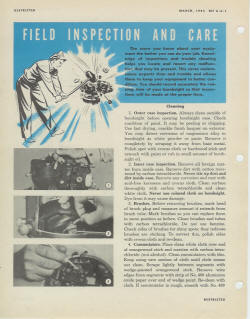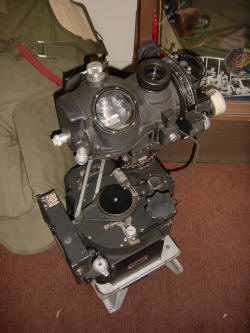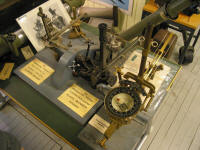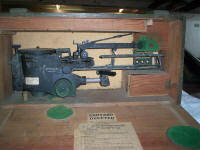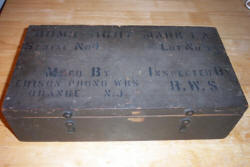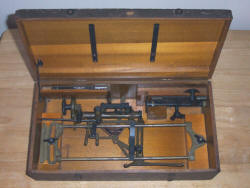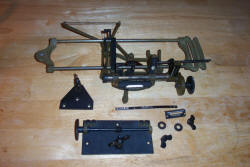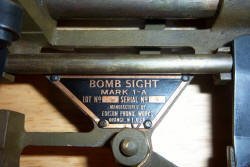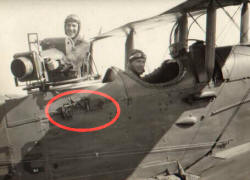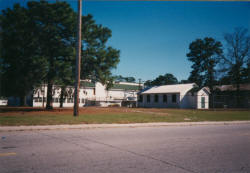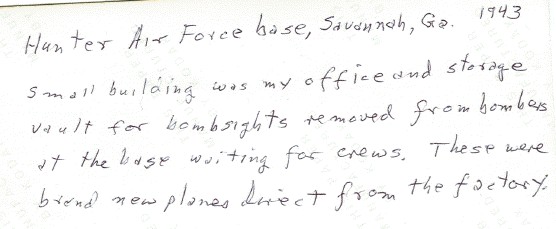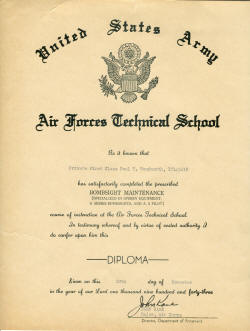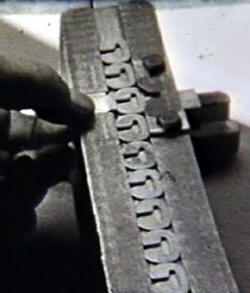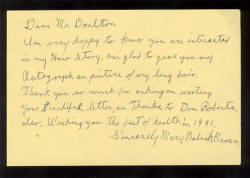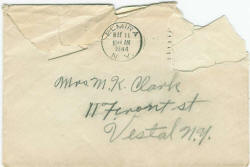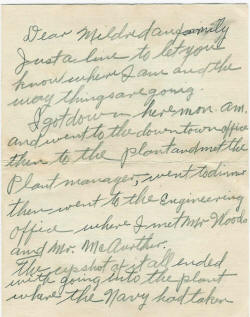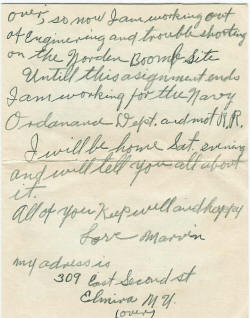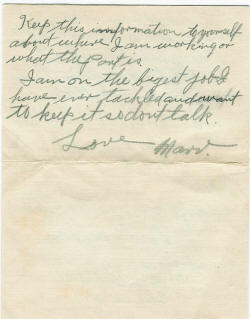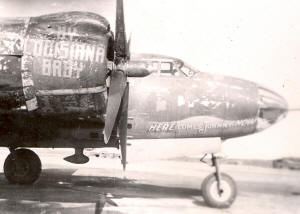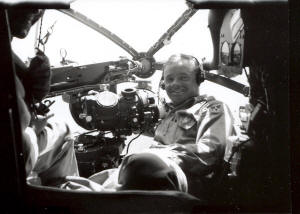Introduction
This is the beginnings of a web site dedicated not only to the Norden Bombsight but it will also include information about the other bombsights as well. The Norden bombsight is arguably one of the most important technological advancements to come out of WWII. Even though Carl Lucas Norden had built a prototype and was developing his bombsight well before, it was its use during WWII which made it famous. Even today people still marvel at the super secret Norden Bombsight.
The development and use of this great computer is a fascinating story. In time, I will present that story on this web site. If you have any information, photos or stories that you would like to contribute please send it to me as I would like to have as much information posted here as possible.
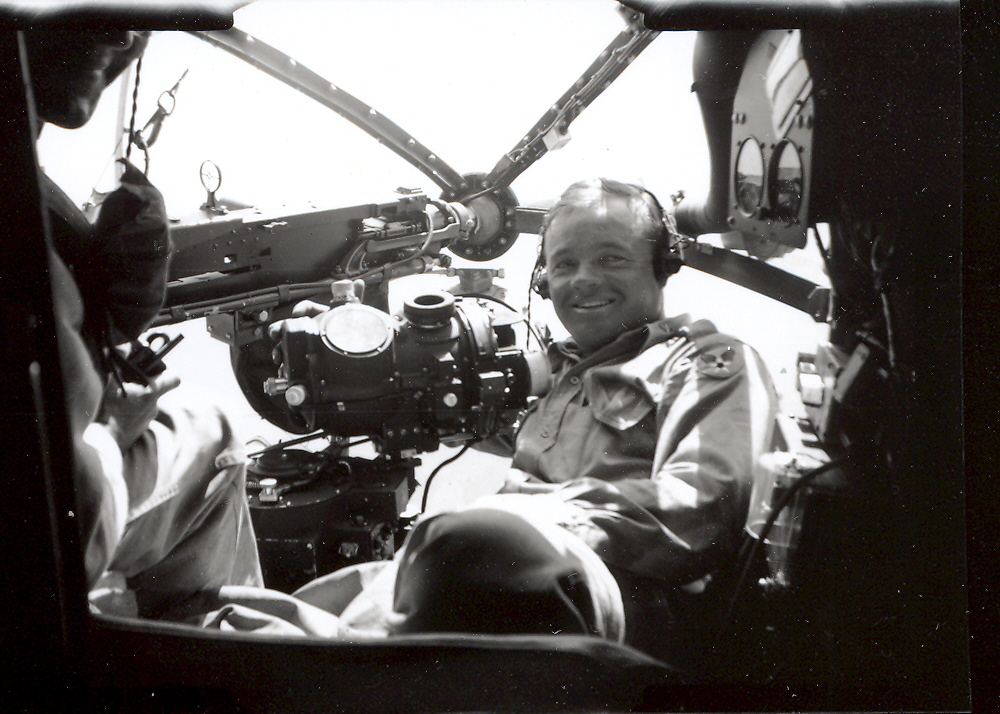
2nd Lieutenant Everett Glen Hanes poses for a picture with his Norden Bombsight in the nose of his Martin B-26 Marauder of the 9th Air Force, 344th Bomb Group,
497th Squadron. For more information on Lt Hanes, click here.
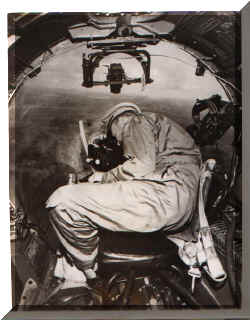
I am also looking for any bombsights parts, components, accessories and technical information for the Norden, Sperry or any other bombsight. If you have anything that
might be of interest please let me know by e-mailing me at taigh@twinbeech.com
Click any image below to see a larger version.
The Norden Bombsight
The image to the right is a close up of the bombsight head, pictured above. The sight head contains the computer which calculates the point in space where the bombs will be
released. Below the rubber eyepiece is the optics cradle which the bombardier sights through. The optics cradle is connected to a gyro which keeps the optics stabilized with
reference to the ground.
The Norden bomb sight is made up of two principal parts; the sight head and the stabilizer (pictured below) which the sight head mounts on top of. The stabilizer is also part of the autopilot (SBAE, AFCE and C-1type auto pilot) and has a gyro that senses deviation about the yaw, or vertical axis of the airplane. The stabilizer is an essential part of the autopilot and will function without the sight head installed.
Many people know about the bomb sight head but few seem know that the stabilizer is required for the bomb sight to function and to be complete. You may have a sight head but in order to have a complete bomb sight you will need the stabilizer. The stabilizer was usually mounted to some form of vibration isolating bomb sight mount. Sometimes the bombsight mount was made by the aircraft manufacturer such as in the PBY Catalina, TBM Avenger and other Navy aircraft. The Army seems to have used a standardized mount in its aircraft. The early war mount was usually some form of the B-6 mount, which was later replaced by the B-7. The B-7 mount is the typical mount used in all of the mid to late war Army aircraft like the B-17G, B-24, B-25, A-26 and the B-29.
This is the Bomb Sight Stabilizer. The Bomb
Sight Head mounts to the stainless steel gear and brass bushing on the upper
right end of the stabilizer. The sight head will pivot about the yaw axis on the
Stabilizer. The large gyro inside the Stabilizer will keep the sight pointed at
the target should the aircraft deviate off course. The Stabilizer, being part of
the autopilot, will turn the airplane back on course. The Bombardier controls
the aircraft through the autopilot and will direct the aircraft on the bomb run.
The connection to the C-1 autopilot is made through the Directional Panel which
mounts on the left side of the Stabilizer as shown in the diagram below. The
solenoid plate on the back of the Stabilizer is called the Directional Arm Lock
and is a part of the C-1 Autopilot installation. It locks the directional arm during turns.
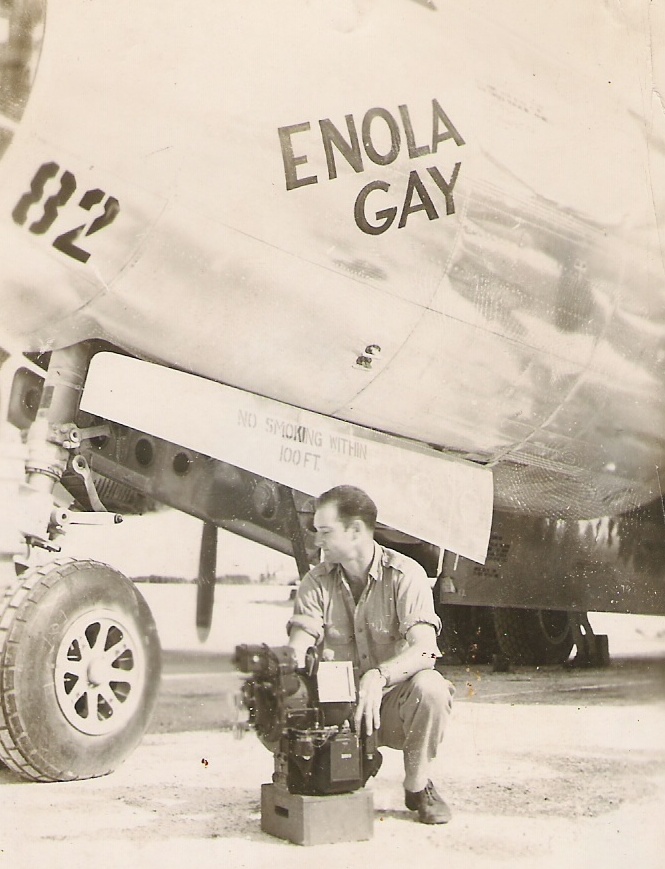
In fact this is the probably the most famous Norden Bomb Sight of them all. Victor 4120, an M9B, is the sight that was used by Tom Ferebee to drop the first
atomic bomb on Hiroshima on August 6th, 1945. This sight is presently installed in the nose of the most famous B-29; the Enola Gay, which resides in the National Air and Space
Museum at Dulles Airport in Washington DC.
To the right is a photo taken after the dropping of the Atomic bomb on Hiroshima. Mr. Ferebee with the sight he used Victor 4120 which now resides in the nose of the Enola Gay at the
National Air and Space Museum as seen above.
This particular version was typical of what was used toward the end of WWII and throughout the Korean Conflict. This is an M-9B bombsight head (L-9772) manufactured by Lucas
Harold Incorporated. The sight head has a Maxon X-1 Reflex Sight and the tachometer adapter for the Glide Bombing Attachment. The sight head is mounted on top of a Lucas Harold
Stabilizer (L-9404). The stabilizer has a Directional Panel and a Directional Arm lock both of which are used with the C-1 autopilot. On top of the stabilizer is an Automatic
Bombing Computer with the HH-1 Tangent Scale Kit. The stabilizer is mounted to a B-7 bombsight mount.
This very sight was used recently to actually drop bombs for a reenactment for a television series called Warplanes. This PBS special is scheduled to air in 2006. This sight was installed in John Ward's old North American B-25 Old Glory and we dropped 100 pound practice bombs at a WWII Army Air Force training base. We had the honor of having a WWII veteran and a Viet Nam veteran who used the Norden in combat act as our bombardiers for this historic event. This sight is the last known sight to have actually dropped bombs.
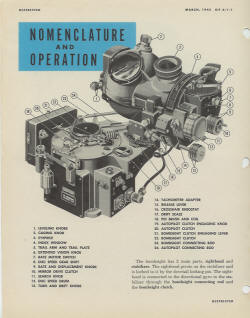
Here is an excerpt from the Bombardier's Information File (BIF) that describes
the components and controls of the Norden Bombsight. For more information on how
the Norden M series bomb sight works and to see the internal systems
click here.
This is a rare early Air Corps M-7 sight head. This M-7 has an Automatic Gyro
Leveling Device (AGLD) mounted on the top of the gyro. One of the reasons the
M-7 is a rarity is that most of these were overhauled and modified during WWII
and the AGLD was removed because of difficulties in maintaining the system in
the field.If you can zoom in you will see the AGLD mounted on the top of
the gyro inside the circular window.
This is a Mark 15 Mod 5 Norden manufactured sight which has the Automatic
Erecting system installed. This sight head and stabilizer are one of the rare
sets that have matching serial numbers. Norden sights were shipped as matching
pairs that were adjusted at the factory. It is extremely rare these days to find
sight heads that match their stabilizers. I know of two, this one and the one
installed in the B-29 the Enola Gay at the National Air and Space Museum at
their Dulles facility. If you know of any other sets please let me know as I
would like to document them.
This particular sight was installed in an Army Air Force Beech AT-11 Kansan bombardier trainer. I have added a different directional panel that was used in the US Navy's Stabilized Approach Bombing Equipment or SBAE autopilot. This sight was manufactured in April of 1942 and still has the date on the data plate. There was a technical directive that had the manufacturing dates removed from equipment so it wouldn't help the enemy to determine what improvements may have been made by the dates.
You can see that the directional panel has two large knobs on it and an electrical connector to the stabilizer. These knobs are actually pulleys for metal bands that were used for a mechanical follow up system for the autopilot. These bands would connect to the vertical gyro. The early Automatic Flight Control System (or AFCE) as used by the Army Air Corps with the Norden M series sight used a mechanical follow up system as well. I understand that Minneapolis Honeywell developed an electrical follow up system that was incorporated into the later C-1 autopilot system.
Also of note is the Automatic Bombing Computer (or ABC) that was installed on the top of the stabilizer. This computer allowed lateral evasive maneuvering on the bomb run without the bombardier having to re do his calculations. The greenish canvas bag held the scales for the ABC and would snap onto the rear of the stabilizer as shown.
This is a close up view of the top of the gyro on the Mk15Mod5 sight. This sight
was equivalent to the M-7 Army sight as shown above. This photo shows the
Automatic Erecting System or AES. The Army called it the Automatic Gyro Leveling
Device or AGLD. Very few surviving sights have this modification as most of them
were removed, by technical order at the depot level, due to the complex
maintenance required to keep them operating. Keeping the gyro level on the bomb
run was critical; if the gyro was just a half a bubble out it would throw the
bombs off the target an appreciable amount. In this example the leveling bubbles
have been removed and would have been installed in the lower left corner. This
system is very similar to the erecting system use in the vertical gyro of the
C-1 autopilot which leads me to believe that it was designed by Minneapolis
Honeywell.
This is a Lucas Harold manufactured Mark 15 Mod 7 sight head (L-518) that came with a Navy log book
that shows that it was installed in a Consolidated PBY-5A (Bureau number 48450)
Catalina flying boat. The log book shows that the the sight head has bombing
history.
This is a Victor Adding Machine M-9B sight head (V-2314) that new and is still
in its original shipping box. Sight heads and stabilizers that are still in the
box are getting very hard to find these days.
Here is the Lucas Harold
sight and stabilizer above installed in the nose of my old Beech SNB-1 (Navy
version of the Army AT-11). For more information about the Beech AT-11 Kansan
bombardier trainer click here.
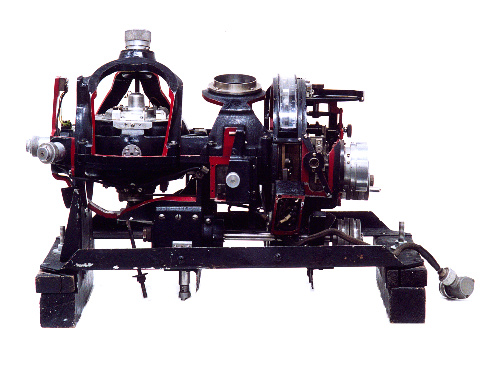
Here is a cut away of a Norden
sight head. For more information on how the Norden M series bomb sight works and
to see the internal systems click here.
Here are some students learning about the
bombsight in the classroom at Mather Air Force Base near Sacramento, California.
Both this and the next image are quite large so they will take a while to load
if you click on the thumbnail.
This is the A-6 bombsight trainer that was used to train student bombardiers on
the ground. This was a highly advanced trainer as compared to the earlier A-2
system. If you know where I might find any parts to the A-6 or the A-4 bombsight
trainer please let me know at
taigh@twinbeech.com
Here is a great rare
wartime shot of two bombsight mechanics working on a Lucas Harold built sight
head serial number L-581 and a Lucas stabilizer serial L-5037. Bombsights and
stabilizers were originally issued as a matched set from the factory. They were
intended to remain as a set but that practice soon became too difficult to
maintain.
A technical order was issued on how to match sights and stabilizers
with different serial numbers. The main issue being the fit of the drift worm
gear with the sector arm. A fascinating thing to take a look at is the board on
the right side of the photo. It shows the various sights and stabs and what ship
they were installed in. Of the thirteen sets on the board all have matching
serials except the very set that they are working on. This photo is
supposedly from the Burma Theatre of operations. It would be interesting to try
and correlate the ship numbers (possibly the last three digits of the serial
number) with the aircraft serial numbers to determine what type of aircraft
these sights were in. It would be quite difficult but it would sure be
interesting to figure it out.
This is the main electrical connector for
the Norden Bomb Sight. This connector attaches to the stabilizer and carries the
main DC electrical power to run the sight along with the bomb release circuit
and Pilot Directional Indicator or PDI wiring. I have extra connectors available
for sale or trade so if you need one for your bomb sight just e-mail me at
taigh@twinbeech.com.
This is a filter kit that was used with the Norden sight. It was made by
Polaroid and would help the bombardier to see the target by cutting down on
glare and haze which was obscuring the target. The kit has a special rubber eye
piece and changeable filters that fit into the special eye piece.
I am in need of these filter kits so if you know where I could find one please
let me know at taigh@twinbeech.com
Another item that I am
looking for is the Glide Bombing Attachment. This device was used to allow the
bombardier to perform vertical evasive maneuvers while on the bomb run. This box
controlled the disc speed inside the sight head and it was also connected to the
pitot system of the aircraft. Inside the GBA was a sensitive bellows that would
detect changes in altitude. As the aircraft would climb or descend the internal
motor would drive the disc in the sight head through a flexible shaft connected
to the tachometer adapter. If the aircraft was climbing the motor would turn
slower and visa versa for a decent.
Normally the GBA was mounted on the back of the stabilizer over the gyro cover plate. If the C-1 autopilot was used the directional arm lock would prevent this installation and it would have to be mounted remotely. This remote installation was typical for almost all Army Air Force aircraft as it was a standard practice to have the C-1 installed whenever the Norden M series sight was used. If you know where I can find a GBA please call me at (209) 982 0273 or email taigh@twinbeech.com.
The Norden Bombsight was an Overrated Piece of Equipment?
There has been a lot of talk recently that the Norden Bomb Sight was not all that good and that its reputation was based on hype. This seems to me like the revisionist historians rearing their ugly heads again.
From my research, and from talking to bombardiers, I believe that the bomb sight was only as good as the person who was using it. A bombardier who new his sight could obtain very accurate results. The Army Air Forces adopted a procedure where the best bombardier was designated as the lead bombardier and was placed in the lead aircraft of the formation. As the lead bombardier dropped his bombs the rest of the formation would drop with him. The results were greatly improved over the individual release results. The bomb sight was a great tool and was highly effective in all fronts of the war.
There seemed to be a big difference between the aerial bombing strategies used during WWII. The Germans and the Japanese mostly went after strategic military targets or areas of population . The US attacked the strategic military targets along with the industrial targets. The idea was that if you can stop the manufacture and flow of the equipment to the war effort then you will eliminate the enemy's ability to wage war. The Norden Bomb Sight was designed for the purpose of dropping bombs accurately on specific targets. It was also designed to put the mean point of impact on the target while walking the stick )or train) of bombs up to and away from the impact point.
The Norden sight was a good weapon system that did a great job. Maybe it wasn't able to put that 500 pound bomb into a specific part of the pickle barrel from 10,000 feet as Mr. Norden said, but it certainly did get the bombs on the intended targets.
If the bomb sight was such an over rated piece of equipment then how did those targets get destroyed? By pure luck? Was the bombardier just sighting off of his big toe? I think that credit needs to be given back to Norden and Sperry for their awesome contribution to the successful outcome of WWII.
Please help put those revisionist ideas to rest. Don't spread those fallacies around. Let the history speak for itself and listen to those who were there.
In response to a post about the shortfalls of the Norden bombsight I replied with this rant:
Let me pre-apologize for the following rant:
I love the revisionist historians take on the lack of accuracy of the Norden bomb sight in WWII. Yes the whole bombsight program was very expensive to develop and put into service but what else was available at the time?
The pre WWII bomb sighting systems were not far removed from what was available in WWI which was very close to holding out your arm and using your thumb. Accuracy depending on the state of your manicure. Really, take a look at the sights in WWI and compare them to what was available going in to WWII. Not much different. Wires with increments to sight across and drop when the target crossed preset indices. Would the same sight for a wood and linen 80 mph biplane bomber from WWI really work from the altitudes and speeds of the newly developed bombers coming online in the late 1930's?
Coming up with an electro-mechanical computer that would take into consideration all of the factors needed to calculate the point in space to drop a specific type of bomb at the speeds, altitudes and conditions of a brand new type of combat was quite the challenge in the 1930's don't you think? Now try to get that mechanical computer to do that accurately at 40 degrees below to 150 above.
Let’s also figure out how to reproduce this computer, in the massive quantities needed, that required more precision than some of the finest watches of the time.
It also turns out that the pilots flying the aircraft had trouble maintaining the accuracy for a stable bombing platform so they needed to come up with a full three axis autopilot to work with the bombsight to be able to fly the aircraft on the bomb run. Let's pull one of those systems off of the shelf in 1935. Sort of like going from a BC-375 to an ART-13 isn't it, but a wee bit more complex I suspect.
Then don't forget to make the bombing system simple enough so a kid fresh from the farm in Kansas can figure it out since we are going to need tens of thousands of bombardiers to man the aircraft that are coming out of the factories one every hour. Let's also figure out how to train all of these kids on a system and bombing problem that hasn't been thought that much of...ever before...and get them through the new schools and off to combat. It's okay if they weren't the best bombardiers as they wouldn't live that long anyway.
Let's take it out on the Norden Bomb sight and blame it for being an inefficient program and an ungodly expensive system. A waste of money and time as that seems like the right place to point to for the bombs missing the target. Crappy accuracy? Why was it that the German infrastructure and war industry was brought to a screaming halt? Why was it that the aircraft factories and other critical industries had to be moved underground or into houses and spread around the country to protect them? Why was it critical for the last German offensive in the bulge to capture the allies fuel storage so they could keep moving? What was it that destroyed the airfields and made the once mighty Luftwaffe a lot less of a concern?
May I offer that it was the British bombing by night and the precision bombing by the U.S. by day that brought the German war effort to a halt on the West and the lives of 5 plus millions of Russian soldiers that perished in the East. I believe that it was precisely this bombing effort, the likes of which had never been seen before, that made it a lot easier for the allied ground forces to move across France and into Berlin from June 6, 1944 to May 8th, 1945
May I offer that we needed a whole lot better bombing system than anything that was in play at the time. We needed a revolutionary new system on the same order of importance as RADAR or the nuclear program. A system to solve a complex problem that hadn't needed to be worked before.
May I offer that it did take out the strategic targets. It did take out the airfields and oil industry. It did take out their war effort. It did work
May I offer that it might not have been the best for you looking at it through today’s eyes. It was the best that they had at the time and they were proud even if you are not today.
Rant over. Nothing to see here. Please move on...
Do you have Norden bombsight head serial number L-9091 ?
If so please contact me at taigh@twinbeech.com.
This bombsight was sold on eBay around 2005 and we helped the owner with information about the sight.
If you have this Norden bombsight, serial number L-9091 please contact me as I would like to share some more information about your sight.
The Sperry
This is the Sperry S-1 Bomb Sight. This was the only sight that was in competition with the Norden M series sight. I was told by Instructors and Bombardiers that used this sight that it was just as good as the Norden and was easier to use from an ergonomic standpoint. When running the Norden one would have to be a bit of a contortionist to reach around and under the sight head to simultaneously work the controls on the right side of the sight with both hands while sighting through the eye piece. The Sperry, on the other hand, was set up with controls on each side that were easy to operate by the bombardier. The Norden M series was eventually chosen as the bombing system of choice and thus the Sperry system was cancelled. The Sperry sight used the A-5 autopilot system to control the aircraft on the bomb run which was a very advanced autopilot.
This particular sight was accepted by the Army Air Forces on May 11, 1944 and has the M2 modification incorporated into it. The sight also has the autopilot gyro attached to the aft end of the sight. These sights were used in many different bombers in WWII and were also installed in the Beechcraft AT-11 Kansan bombardier trainer. For more information about the Beech AT-11 click here.
This comparison shot
shows the basic Sperry S-1 and the S-1 with the Modification 1 and 2
incorporated. The S-1/M2 also has the additional gyro attached to the back of
the sight (with the number 7 painted on it). This gyro was used to interface
with the autopilot and could be mounted to all versions of the S-1 sight.
The biggest difference between the two is the addition of the scales for tangent of the dropping angle, altitude and sighting angle.
This is the sighting head for the Sperry
T-1 sight. This sight is very similar to the British Mark XIV sight that was
used in many of their bombers. The T-1 was used in lend lease aircraft. Most of
the surviving B-24's today had this sight installed. All of the B-24's that came
from the Indian Air Force (Collings, Pima Air and Space Museum, RAF Cosford,
Kermit Weeks) all had these sights installed in them. The T-1 head was connected
to a computer that mounted on the wall of the bombardier's compartment through
two flexible shafts. The gyro was vacuum operated and is very similar to the
gyro used in a standard attitude indicator.
The D-8
This is the D-8 bomb sight
which has also been called the Estopey sight. It was used in training and in
combat in many different aircraft. Recently a B-25C was brought up from a lake
in South Carolina. One of the recovery photos showed that the aircraft was
carrying a D-8 sight (photo below by Bill Jackson). The example in the photo
above was made by NCR Inc. or National Cash Register.
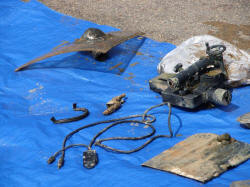 Here is Bill Jackson's
photo of the D-8 sight from the Lake Murray B-25C. For more awesome shots of the
recovery of this time capsule click on this link:
http://community.webshots.com/user/lakemurrayb25 Gary
Larkins and his team or Air Pirates did the recovery of the B-25. For more
interesting shots from their crew click here:
http://www.airpirates.com/gallery/Lake-Murray-B-25C-Recovery?page=1. Also in
the photo is the throat microphone for the bombardier and what looks like one of
the leather handles from the bombardier's E-1 briefcase. The item in the upper
left is a piece of Plexiglas with a ball socket for the 30 caliber ANM2
machinegun.
Here is Bill Jackson's
photo of the D-8 sight from the Lake Murray B-25C. For more awesome shots of the
recovery of this time capsule click on this link:
http://community.webshots.com/user/lakemurrayb25 Gary
Larkins and his team or Air Pirates did the recovery of the B-25. For more
interesting shots from their crew click here:
http://www.airpirates.com/gallery/Lake-Murray-B-25C-Recovery?page=1. Also in
the photo is the throat microphone for the bombardier and what looks like one of
the leather handles from the bombardier's E-1 briefcase. The item in the upper
left is a piece of Plexiglas with a ball socket for the 30 caliber ANM2
machinegun.
This is the British Mark VIIA Course Setting bombsight which was used extensively
in WWII land bombers according to Allan Hunter.
Here is an e-mail that I received from Allan Hunter about the use of British bomb sights. I really appreciate any corrections and additions to this web page. It is important to me to get this right so please feel free to send in your comments.
I do not think I'm in error here. My father's log book clearly mentions when he first used the Mark IX sight, and it was when he transferred to the faster Bristol Beaufort after having trained on Battles, etc.
One way to check would be to read off the top-most airspeed setting on the Mark VII and then compare that to the usual cruising speed of the bomber concerned. I only have examples of the Mark IX or I could do this for you.
Respectfully, Allan Hunter"
Here is the groundspeed scale that
shows the top speed as 240 MPH.
Another e-mail from Allan:
This meant that the Mark IX had a maximum speed setting on the front arm of 310 mph groundspeed, and was geared for a maximum height of 14,500 feet (these are the settings on two of mine). These are the most important settings. I don't knowexactly what they are onthe Mark VII asI don't have one to compare. I think this is where the major difference lies. Perhasp you can correct me if I'm wrong, here.
Applications: the Mosquito had a top speed of 392mph, so it wouldn't have used anything except a Mk XIV sight. The Lancaster went up to 287mph, less when fully loaded, so the Mark IX would have beenthesight on that, unless it had a Mark XIV - which was often reserved for Pathfinders, I believe. The Stirling (270mph tops), Halifax (265 tops), Beaufort (260mph), Blenheim (240-278 tops) and even the Hampden (254 tops) would all have used a Mark IX since their attack speed would be lower than their top speed. Most planes -as you know better than I - wouldn't come in to bomb at their top speed, especially on long runs when fuel would be carefully used.
The Mark VII was, therefore, probably used on the Avro Anson (188mph), the Airspeed Oxford (182mph), the Sunderland (213mph), the Battle (240 mph, max.), the Whitley (cruised at 185, top speed 220), and planes like the Vickers Stranraer and the Walrus (160 and 135, respectively). The early Wellingtons were slow at 230mph top speed, but later versions were faster, sovariantswould have used both sights in the course of the war. The Hendon Museum has a Supermarine Walrus with a mark VII sight hung over the right side of the front gunner's position, in the breeze. In fact the Mark VII usually came equipped with a long leather lanyard that clipped onto the left hand side of the sight (yours will have a small ring on the main body, behind the attaching place) so that bomb aimers could be in the open breeze of various aircraft and not risk losing the whole thing out of the open hatch....
WellI hope this helps in some small way.
Best, Allan"
It sure does Allan, thanks!
Here are some photos from Allan:
This is the British Mark XIV sight head. This head was connected to a remote
computer via flexible shafts and an electrical connector. This sight was used
extensively throughout WWII and well into the 1960's. This sight is very similar
to the Sperry T-1 sight (shown above).
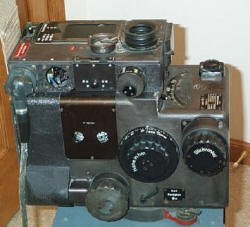 This is the German Lofte Bombsight that was used in many Luftwaffe aircraft in
WWII. This photo provided by Todd Pederson.
This is the German Lofte Bombsight that was used in many Luftwaffe aircraft in
WWII. This photo provided by Todd Pederson.
We are hoping to add examples of the German and Japanese bomb sights to our museum collection. If you know where we could find these or any other sights please contact me by e-mail at taigh@twinbeech.com or please call at 209 982 0273. Thank you in advance for your help.
The photos below are a World War One bomb sight made by the Edison Phono, Works of Orange New Jersey. This is the same company that Thomas Edison started. This sight was typically mounted on the outside of the fuselage and the bomb aimer would lean over the side to sight through it. It has a lot of similarities to the Mark 7 Course Setting bomb sight that was used in WWII.
I purchased this sight from an eBay auction and thankfully it is in excellent condition. If you have any information about this sight or how it was used please let me know as I would like to post more information about this and other early sight. My knowledge of these early sights is woefully inadequate so any information is greatly appreciated. I am also looking for any other bomb sights to add to our growing museum collection. If you have something of interest please let me know by e-mail at taigh@twinbeech.com or please call at 209 982 0273.
This is the US Navy Mark 23 Mod 6 bomb sight. I do not know a lot about this sight except to say that I have seen it installed on the P2V Neptune nose turret. Any information about this sight would be greatly appreciated.
This is a Mark 23 Mod 7 sight head which is
presumably used with the system above. This head has grips and an optical sight.
Any information is greatly appreciated.
This is believed to be either an E-1 sight
or an LLBS (presumably; Low Level Bomb Sight). The data plate references both. It
looks like it is a British sight and has a Dehavilland sticker on it. It has a
lot of similarity to the T-1/Mark XIV sight of WWII fame but looks to be late
fifties to me. Once again any information is appreciated.
A Note about Al Pardini
It is with great sadness that I have to announce that Albert Pardini passed away on Friday January 16th, 2004.
Al was a great man who ran the bomb sight overhaul shop at McClellan Air Force Base in Sacramento during WWII. Every bombsight in the Pacific Theatre that was overhauled was sent to his shop. Al was responsible for many Norden bomb sight improvements and received several awards for his efforts. One of his proudest achievements was a working bombsight made out of Plexiglas as a demonstration model. Recently he authored the book The Legendary Norden Bombsight which is a great piece of technical work about the development of the sight.
I enjoyed listening to Al's stories and I learned so much from him. Thank you for what you did for our country.
We will miss you Albert Pardini!
Email Submissions
Here is an e-mail that I received from a gentleman with some first hand Norden History:
My name is William S. Bowser. I was employed by the Lukas Harold Corporation, operators of the Naval Ordnance Plant Indianapolis, from Oct 1941 to 1945. I initially was an instructor at their training center prior to the completion of the building at NOPI. I setup a number of the manufacturing sections, worked in the laboratory under L.T.E. Thompson, did research on gimbal bearings at Carl L. Norden in New York where I met both Norden and Barth, and eventual ended up in the Engineering Dept at NOPI doing a production redesign of the Norden Bombsight and the production design of the Mark 18 Computing Gunsight. I received the United States Navy, Bureau of Ordnance Naval Ordnance Development Award for Exceptional Service to Naval Ordnance Development 10 Dec 1945.
Over the years because of security and politics it was not advisable to set the records right on a lot of things that happened. In researching current info on the Internet there are a number of things that could be cleared up as to what happened back then. The Norden Bombsight had a great concept but the production drawings were inadequate. At NOPI after I supervised the total production redesign the production at the plant jumped from 80 units per month to 800 units. The Navy, Norden or Barth never admitted that. Prior to the redesign parts were made to very tight tolerances but many parts would not assemble properly and were polished by hand to fit in assembly generally in a degraded condition. I had 5 rejected sights dismantled and found that 25% of the precision parts were modified from production by assembly workers.
The head of Engineering at NOPI was the Naval Officer who hit the pickle barrel at Dalgren. He reviewed the bombing runs he had made with the same bombsight and aimed at a offset point that corrected the consistent error and did hit the barrel set at the center of the aiming circle. It is to be noted that the Norden Bombsight was really accurate when it left the test stand but it required exact info to be set into it to be accurate and a couple of typical bomber landings would put ball dents into the gimbal bearings and gyro precession would result from friction. If you have any questions send me an email.
Bill Bowser
Here is another e-mail I received from Thomas Hurry, a bombsight mechanic in the European Theatre during WWII. If you have some bombsight experiences or photos to share please send it to me in an and I will post it for others to enjoy.
My experiences as a Norden
bombsight mechanic
By Thomas Hurry, 13077443
(Please excuse any omissions or
inaccuracies, my memory has dimmed over the years.)
BACKGROUND:
Enlisted--28 March 1942
Discharged--11 Dec.1945
ETO--27 months-England,
France & Germany
Basic training--Keesler Field
Biloxi, Mississippi
Bombsight school--Lowry Field
Denver, Colorado
As a bombsight mechanic, we were required to make
major repairs on the sight. These repairs included bearing changes, rotor
balancing, lapping and polishing of discs, cleaning components and most
importantly calibration of the sight. The most important part was the gyroscope rotor balancing so that the natural
precession of the cross hairs was maintained.
When we arrived in England our Service Squadron set up shop at the Stanstead Air Base, which was located North of London. This was the time when the Luftwaffe was bombing London nightly. Our field was primarily a B26 bomber base, there were also British Horsa and American gliders on the base US & British heavy bombers as well as B26 bombers were conducting heavy raids both day and night. This resulted in a heavy workload for the bombsight shop.
Because of the violent maneuvering after a bomb drop and rough landings due to damaged air craft, the sights were out of adjustment generally. There was a caging device that was used to protect the sighting mechanism and gyroscope, but this was not a 100% effective.
REPAIR & MAINTENANCE PROCEDURES
When sights came in from Bomber
Command for repair, the procedure was to visually inspect the exterior. Damage
was assessed to determine if they warranted further inspection. If exterior
damage was so great and could not easily put in order, the sight was shelved for
possible use for parts.
The sight would now be tested for accuracy by putting it on a calibration stand.
The stand was very heavy and was made of cast iron. The base was flat and had a
vertical column about three inches + in diameter. The column had a flat surface
on top of it on which the sight was mounted. The height was such that a
technician could lean over slightly to put his eye on the padded eye piece,
CALIBRATION
The sighting telescope indices
would be set at zero and a look down the telescope at the calibration stand base
would tell us where a small mirror (about two inches in diameter) should be
placed. The mirror had three adjustable legs. Using them and a tiny, high bubble
resolution level, the mirror was made to be level in all 360 degrees
This was a difficult procedure and was hard to maintain due to vibrations from
heavy trucks and planes taking off and landing nearby. But a miracle took place,
someone, I don't think from our shop, had a brilliant idea. A small deep saucer
type dish had several pounds of mercury put into it and it became an ever level
mirror. Give that man a medal.
When a telescope sighting was taken, the bottom of the telescope was seen inside a series of several small circles. The image of the bottom of the telescope and the circles had to be concentric. If they were not, the telescope had to be manually adjusted until they were. The indices was set on zero and now the real work began.
As a natural law the vertical axis of a gyroscope preceses in an orderly North-East direction. As the sighting telescope with its cross hairs is connected to the gyroscope, the precession has to be within acceptable limits. The power to the gyro is turned on and a cross hair sighting is taken with the cross hairs centered on a grid located on the base of the precession stand. Two minute readings ,using a stop watch are taken and the N-S precession of he cross hairs must be within acceptable limits. If they are not an adjustment to the gyro rotor must be made.
This was generally done by adding weight to appropriate spots on the rotor, sometimes just the marking of a soft lead pencil would be sufficient, if not paper thin washers were applied. When the result of this procedure was deemed correct, sometimes a second pair of eyes checked for absolute accuracy. This calibration insured that the cross hairs would stay on target despite the movements of the plane while on the bombing run of about forty five seconds. A spring powered hand operated device attached to the sight assured that the cross hairs stayed on target at all times during the bombing run. The coiled spring on this device sometimes had to be re bent, we had special pliers with bent jaws. My nomenclature has not been good during this explanation, please excuse my dimmed memory.
The gyroscope rotor was heavy and cup shaped. Inside the cup area was a tiny elec. motor which supplied the power to spin it. The power to the motor was supplied by two very thin wires, we called them pig tails. When all checks and tests were made and found to be correct, the bombsight was now operational. The log book was signed and it was put in storage.
After the invasion on D-Day and an air field in Cambrai, France was secured, our service was deployed from Stanstead England to Cambrai. There was a civilian technician from the Norden Co. that could be consulted if it was necessary.
Now, I shall relate some incidents that happened along the way. When in Lowry Field, Colo. we were called mess kit repairmen.
In Europe the elect current was 220 volts, this meant we had to use a rectifier to get the 12 or 24 volts needed for our repair work. In England, we had a fairly large apparatus with a glass (ten gallon size) container which glowed violet when turned on. This was lost in transit when we shipped to France. We absolutely had to have a rectifier. There was a British base close by and after going there and telling them our tale of woe, a generous supply Sgt. loaned us one. Now get this-- it was about the size of a DVD player and weighted about four pounds and we could dial any voltage we desired. When ours finally turned up a hoist was required to put it in place.
When changing stations, I goofed off to spend a night in London; this was the first night that the buzz bombs came in. Guess who left London the next morning. Because the shop had to be warm in order to calibrate to calibrate the sights (metal expansion) Bomber Command always made sure that we had coal to use.
The war is over, a helluva experience but one not to repeat. After a relatively short length of time, I lost contact with my bombsight buddies. The bonds between repairmen are not like the bonds between soldiers who experienced combat together
This is the calibration stand that Mr. Hurry was talking about. Just click on the image for a larger picture. If you know where I can find a calibration stand for our museum please let me know at taigh@twinbeech.com.
Click here to read an account of the training and combat experiences of one of our countries greatest generation heroes: Bentley Weitzman, Bombardier, 5th Air Force, 380th Bomb Group, 530th Bomb Squadron
Here is an e-mail that I just received from Harry Hinds who was a Bomb Sight Tech in the South Pacific.
Thanks Harry for sharing this with us and for your service in WWII. We are a Nation grateful for the contributions of the wonderful people like you.
Please keep sharing your stories, we can't get enough!
August 7th 2017
Just a note on behalf of my father S/SGTWilliam Smith 573rd Bomb Squadron. He was inducted on OCT 19 1942 and was put into active service
on NOV 2ND 1942. My father was of the generation that didn't talk much about his service , he as one of the thousands that did what was expected of him and was proud of his service. He was extremely proud too have served as a bomb site mechanic for the norden bomb site.
He would later in life tell some of the stories of having to install the bomb site right before takeoff and would have to run out and remove the site as soon as the planes would return and have to at times be locked in the vaults with the sites because of their importance .
He was awarded six bronze stars for the Europe ,Normandy ,France , Rhineland, Ardennes, Central Europe campaigns. He was discharged NOV 1945. We unfortunately lost him June of this year at the age of 94 years old. But he lived to be a great and proud American and a wonderful father and husbandto all his family.He worked hard and made a wonderful life after his servicefor all of usas a Union electrician taking care of his family.
Sincerely,
James W Smith
Here is a message that I received from Mel Vincent:
Thanks for your hard work on developing the Norden Bombsight website. I don't see any mention of the Navy's use of the sight. A lot of people are unaware that the Navy used the Norden bombsight on the PB4Y Liberator in the Pacific. In 1944 I was a 19 year old AOM 2nd class (Aviation Ordinance Man) in the Navy and was sent to the Norden Bombsight training school in Jacksonville Florida. Our class was trained in both maintenance and as bombardiers. We flew training runs in a Beechcraft twin engine plane equipped with the Norden sight and Sperry automatic pilot. The nose was Plexiglas for the sight and the bombs we dropped were water filled bombs. The target range was somewhere in Georgia, fairly close to Jacksonville. As I recall the results were pretty accurate...we could see the dust fly when they hit.
I don't recall what our altitude was on these runs, but probably 8,000 feet or so. After training we were designated AOMB 2nd class. the "B" for bombsight. From Jacksonville I was sent to Alameda, California and assigned as an instructor in training pilots and bombardiers bombing run procedures. We jury-rigged a couple of Link trainers with the bombsight stabilizer and Sperry automatic pilot for on the ground training. The stabilizer was quite heavy and to counterbalance it, we put heavy window weights (salvaged from the salvage yard) in the tail of the trainer. It worked fine as long as the trainer was flown fairly level...if the trainee put the nose down too far, the Link would nose dive. During my stay at Alameda, I was sent to El Segundo, California to a Sperry Automatic Pilot school, then returned to Alameda. The pilots and bombardiers we trained were assigned to PB4Y Liberators in the Pacific.
In 1945 I was transferred from Alameda to Wold Chamberlain Naval Air base in Minneapolis, Minnesota where I continued as an instructor in bombing procedures using the Norden Bombsight and the Sperry Automatic Pilot. IBM had developed a rather sophisticated simulated high altitude bombing trainer that another fellow and I assembled. The war was almost over at this time and I don't know if it was ever put to much use. It simulated terrain, motion of the plane and was even refrigerated. It was a lot more realistic than the motorized four wheel platforms with the sight mounted on the top we had used in Alameda for bombing training runs. (The platform was guided by the bombsight and stabilizer and it dropped a plumb bob on a paper bulls eye on the floor.)
As a note of interest, bombardiers in the navy were non-commissioned. I've been told the Air Force insisted bombardiers be commissioned because during a bombing run a non-commissioned officer could not be in command. True or not, I don't know.
I was discharged from Wold Chamberlain in March of 1945. I had service manuals for both the Norden Bombsight and the Sperry Automatic Pilot, but being a 20 year old anxious to get out of service, I left them behind. (To my regret.)
After discharge I attended the Minneapolis School Of Art for a short time and have been a working artist (commercial and fine) ever since.
Mel Vincent
Thanks for writing Mel; I am sorry that I haven't mentioned the Navy's involvement in the Norden bomb sight as Mel pointed out. The Navy was in complete command of the Norden sight and Carl Norden worked for the Navy. This presented a big problem between the Army Air Force and the Navy and they were battling each other for quite a while over this. I hope to post more information about this in the future. Al Pardini's book covers the subject in much more detail than I can provide.
Paul Woodnorth sent these photos of the bomb sight vault at Savannah, Georgia where he worked during WWII. Anybody know if the building is still there?
Here is a scan of his diploma as a bombsight mechanic. Note his specialty was in the Sperry S series bombsight and the A-5 autopilot.
You asked about some of my history. I became enamored with aviation when at about 10 years of age my Dad took me for a ride in atwin engine biplane which was originally used as a transport, name eludes me, about 1933.
I volunteered for The Air Corps as I wanted to be near airplanes. I was sent to Bombsight maintenance school at Lowery Field, Denver. From there took some armament training and ended up at Hunter Air Force base, Savannah, Ga. We received bombers from all over but mainly B-17's from Wichita. Most were flown in by a group of civilian ladies. They were a dedicated bunch. We put the crews and equipment together and then the crews flew them to England. While the bombers were at our base we had to store the bombsights at our vault, picture sent. We handled B17, 24, 25 and 26 also A26 and other too numerous to mention. I made sure a sat in the cockpit and bombardier's seat of all the planes. One Mosquito Bomber was my favorites even if the cockpit was a tight squeeze.
While there the first B29 made landed at our base, WOW! With the war winding down in Europe my Sgt. asked if I would like to go to the Pacific. My answer was NO, so I got sent to Libya in the Air Transport Command. Spent nearly a year there till I became ill and had to be flown back to the states in a hospital C54 from Cairo, Egypt. Was discharged on VJ Day. I have the original issue of Stars and Stripes proclaiming the Victory in Europe. I also have 8 "Desert Observer", the camp paper of the Benghazi, Libya Air Base. The B24's flew their raid on Ploesti from our base. Oh, I have a copy of"War Monthly" Issue 23. It has a very good story on the Norden Bomb Sight. Did I bore you?
Paul WoodnorthNo Paul, you didn't bore me. This is great stuff! Thanks for sending it to me.
I had the great honor of meeting the
bombardier of the Enola Gay, the late Tom Ferebee (in the red shirt) and some of
his fellow Albuquerque classmates at a Bombardier's Incorporated convention in 1992. Here is
a nice web page about Mr. Fefebee.
This is Bill Blair with his awesome Norden Bomb Sight Simulator. Bill made this
simulator and he takes it to schools and air shows to show what he and many of
his brothers and sisters did in WWII. We applaud your efforts Bill and we thank
you for what you did during WWII. Bill and his friend Jack Valenty from VO-67
are the most current Norden Bomb Sight bombardiers to date as they dropped 100
pound practice bombs with the sight at the top of this web page (L-9404) out of John
Ward's B-25 Bomber. We set up this demonstration for a PBS special called
Warplanes which is to
air in 2006.
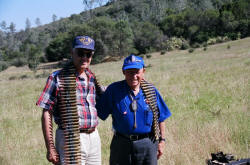 This is Jack Valenty and Bill Blair together and ready for a gunnery mission.
Jack was one of the last bombardiers to use the Norden in combat during the Viet
Nam war. Jack was in the Navy squadron VO-67 and flew P2V Neptune's that had
Norden sights installed. They were dropping sensors on and near the Ho Chi Min
trail. The Norden was well suited for the job thus making the famous sight
useful in three wars: WWII, Korea and Viet Nam.
This is Jack Valenty and Bill Blair together and ready for a gunnery mission.
Jack was one of the last bombardiers to use the Norden in combat during the Viet
Nam war. Jack was in the Navy squadron VO-67 and flew P2V Neptune's that had
Norden sights installed. They were dropping sensors on and near the Ho Chi Min
trail. The Norden was well suited for the job thus making the famous sight
useful in three wars: WWII, Korea and Viet Nam.
For more information about VO-67 please visit their great web site here.
This is the sight that Bill and Jack used in the nose of the B-25. This is the
last known Norden Bomb sight to have dropped bombs on June 1st, 2005. This sight
has since dropped practice bombs from a Beech SNB-1 (AT-11), B-24J, B-25J and
most recently the Collings B-17G
A Note from Taigh
The 60th anniversary of the August 6th atomic mission to Hiroshima passed without much of a fuss at the National Air and Space Museum. There were about 30+ protestors in the front of the museum who were very quiet and civil. One had a sign that said “The Enola Gay is a weapon of mass destruction”. I had to agree with that one. Later they all held hands in front of the nose of the aircraft and prayed. I hoped they were giving thanks for the beautiful B-29 behind them which was restored, reassembled and now proudly on display, but somehow, I don’t think this is what they were praying about.
I had the distinct honor of working on the B-29, the Enola Gay with Bernie Poppert the Director of Restoration at NASM. The Enola Gay is Bernie’s biggest obsession. He and his crew have done a magnificent job of restoration and should be rightfully proud. I have been inside many of the surviving B-29’s and the Enola Gay is by far the most authentic, best preserved B-29 that I have ever seen. She is all original with her factory upholstery, wiring and components. She looks like she could fire up the APU and the rest of her systems and take to the air.
It goes against the grain for me to do this but I have included a photo of myself in the nose of the Enola Gay taken by Bernie. In the photo, I am cradling the Holy Grail of Norden Bomb Sights: Victor 4120 or V-4120. This is the very sight that was used by the bombardier of the Enola Gay, Tom Ferebee, on the August 6th mission, 60 years and two days previous.
I had brought out several parts that I was donating to the Enola Gay restoration effort and, thanks to Bernie; I was able to personally install these items. One of the parts was a directional panel for the Norden bomb sight stabilizer. This unique opportunity afforded me a chance to closely examine the most famous of all the bomb sights. In doing so I noticed that the scale for the tangent of the dropping angle was missing from the indices window and that the rate and altitude knob didn't feel as though they were connected. Bernie gave me permission to open up the rate end of the bomb sight head and I discovered that the whole rate motor and disc assembly was missing.
I know that this specific sight was given to the Smithsonian from the company that built it, Victor Adding Machine, in 1947. It was presented by Mr. Ferebee himself (he personally told me this at a bombardiers reunion years back) so I wondered why this bomb sight would have had parts removed. Bernie just answered this question this morning as he just obtained internal Smithsonian communications with the US Navy allowing the sight to be put on display only after the rate motor assembly was removed.
I have offered to replace the missing parts and to restore the sight to its operational condition as I thought that the sight had been stripped for some incomprehensible reason. I now know that the parts were removed because the rate motor and its constant speed control were the most top secret parts at the time. They were removed for historical reasons. How fascinating!
I hope all of you get a chance to visit the Enola Gay at the Hazy facility of the National Air and Space Museum at Dulles Airport. It is a great example of money well spent; incidentally no government funds were used to build this great facility. Now they are trying to raise the funding necessary to build the restoration shop next to the new museum. This will allow Bernie and the awesome NASM restoration staff to move out of their ancient corrugated tin buildings at the Garber Facility in Maryland. If any of you have any money to spare this would certainly be a great place for it.
Here is a link to the National Air and Space Museum Hazy facility.
Here is a link about giving to the museum.
Here is a letter about the Norden in the B-36 from Col David Dempster, USAF Retired
Thanks David for adding this great information about the use of the Norden in the awesome Peacemaker. I am truly sad that I will never hear the sound of, or see the B-36 in flight.
Hi,
I just found your interesting site via a Google search and enjoyed the photos and descriptive articles about the Norden. I was surprised however, to see no mention of it's role as part of some B-36 equipments.
My first assignment after being commissioned as a 2/Lt Navigator in 1955, was to the 99th Bomb Wing ( H ) at Fairchild AFB in Spokane, Washington. The 346th, 347th and 348th Bomb Squadrons were equipped with RB-36F aircraft ( with the 348th selected to be part of the FICON project carrying and launching F-84 fighters ). I was in the 347th. Our 22 man crews had four Navigators aboard: the table Navigator ( dead reckoning, celestial, pressure pattern, ETA control, etc. ), the Radar Navigator ( radar bombing and navigation ), the Weather Navigator (weather observations, Drop Sonde coordination with the rear gunner dropping them, and manning the nose 20mm cannon turret ) and the Photo Navigator ( steering the aircraft during Photo Flight line runs, operating camera systems in conjunction with Photographers in the Photo Compartment and visual bombsight releases of Photo Flash or Explosive bombs ).
In our RB-36F models, we had the APQ-24 Radar Bombing System with it's APS-23 mapping radar and the Norden Bombsight, used by the Photo Navigator. Other B-36 models had the K-System installed which was a much more modern Analog Computer System integrated with it's Radar system and an Optical Periscope type Bomb Sight ( the latter being the standard equipment in B-47E bombers and some early B-52 models ).As a youngster, really wet behind the ears, I had great instructor Navigators ( some WW II recallees for the Korean War ) who checked me out in the operation and use of the Norden and radar bombing systems. I even had a few opportunities to drop some small practice "marking bombs" with the Norden on training ranges ( one north of Guam in the Mariana Islands chain ).
Good memories and good experiences, that did me well as I progressed on in my flying career in B-47E, B-58A, SR-71A and AC-130A aircraft. Eventually I became more accustomed to Astro-Inertial Nav Systems and sophisticated computer systems than in my early days of adjusting Disk Speed settings, but I still remember my Norden Bombsight experiences with fondness and nostalgia.
Can't tell which other RB-36 models or units were also equipped with the Norden, but I'll bet that info is out there in cyberspace somewhere, if it's of interest to you and your great website.
Thanks.
David P. Dempster
Colonel, Retired, USAF
Here is a photo that I took inside of the
B-36 at the Castle Air Force Base Museum in Atwater California. This is the nose
or bombardier's station where the Norden bomb sight was installed. The oval
window was the optical glass that the Norden sighted through.
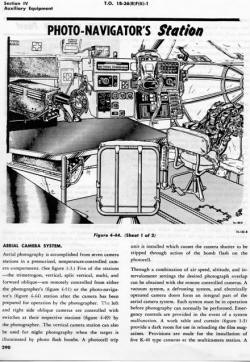
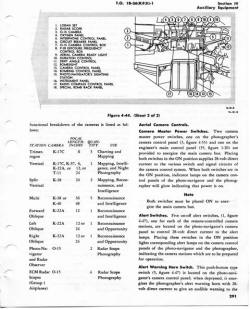 David sent in these scans from the B-36 flight
manual. These pages show the Norden installation in the nose of the B-36. Thanks
David for sending these to us. We really appreciate it.
David sent in these scans from the B-36 flight
manual. These pages show the Norden installation in the nose of the B-36. Thanks
David for sending these to us. We really appreciate it.
Help needed. Here is a photo of a part that a gentleman needs help in
identifying. Here is the story:
Mr. Ramey,
I have recently completed my research on Frank S. Milburn, who I believesecretly manufactured acomponent of the Norden bombsight in his machine shopin Burlington, KY, during WW II. Mr. Milburn died in 1984 but Ihave interviewed a number of folks who said that Frank told them that he made this part during the war. Two weeks ago, I finallyspoke to one of the woman who worked in the shop makingthe parts.
During the war,Milburn employed Mrs. Irene Scott and her daughter Pat in the shop. They lived on an adjacent farm and were the only employees. As Pat (now in her mid-70s) recalls, one day a naval officer showed up and had a long talk with Frank. After he left, Frank came out and told her and her mother that they were going to start machining some precision parts but that he could not tell them what the parts would be used for. Frank designed and built the machine himself. During the day, Irene used the machine to make the parts. Patspent a couple of hours after school measuring the parts with a gauge. She described the part as being the size ofa nickel with a keyhole slot cut into it. That description jogged my memory and I realized that I actually have film footage of Irene Scott making the parts! I'm attaching a screen capture from the film, showing a close up of the part in question. Every couple of weeks, Mr. Milburn would take box of the completed parts and drive them to the Gruen Watch Factory in Cincinnati in the middle of the night, a pistol at his side.
My hope is that someone who has worked on the Nordenbombsight or dismantled one will be able to identify the part fromthe photos. That will solidify the argument that Frank Milburn was indeed secretly making a part for the bombsight here in (then) sleepy Burlington, KY.
Best Regards,
Matthew E. Becher, AICP
Rural/Open Space Planner
Boone County Historic Preservation Review Board
And another submission, below.
Sir,
I just found your Norden Bombsight pages and I am very impressed. I am a retired Air Force Navigator (53-75). I was a Navigator Instructor at James Connally AFB, Texas flying the Convair T-29 from 54 to 59. The T-29 had a Norden Bombsight mounted at the very rear of the aircraft. Ihave never figured out what the purpose of the Norden was because the T-29 was not configured to drop bombs. Do you have any idea what it was used for?
God Bless,
James G McGinnis, Lt. Col., USAF Retired
This is the first that I have heard of a Norden mounted in the Convair T-29. Does anyone have any information about the Norden bomb sight being used in the T-29? If so please let me know and I will post the information here.
Thanks for writing Col. McGinnis
Here is more about the Norden used in the Convair T-29 from Ron Fullmer:
The T-29 was a radar sited bombardier and navigator trainer. The Norden bombsight had a Bosley B-2 35 mm camera mounted on the eye piece and recorded bomb strikes by the radar. Ron Fullmer
Thanks for the information Ron. Should you or anyone have any more information, photos or other technical information about this please let me know so I can post it here.
The Norden bomb sight has taken a lot of flak over the years, some warranted and some not. I wasn't there so all I have to go on is what I have heard from the folks who were. Here is an e-mail from someone who was there: Brad who was a gunner in the 8th AF.
Maybe you would like to comment on my thoughts...I was a gunner who flew 35 mission with the 8th Air Force back a few years ago...I had the opinion then and still do that the Norden Bomb Sight was not as good as it was touted to be....
I know on several occasion we dropped bombs that came no where near their targets...We even took a shot at the Remagen Bridge and missed completely...I always wondered why on many mission there was a lead ship with a bombardier who targeted the target and when his ship dropped its bombs, the rest of the flight would do likewise...As near as could tell the bombardier hit the toggle switch when he saw the lead ships bombs drop and that is about all...
Let me know your thoughts if possible...Thanks...
Brad
And my response to Brad, below...
Hello Brad,
Since I wasn’t there I am hardly in a position to judge the effectiveness of the sight. I have talked to many bombardiers over the years and I have heard many say that it was a very effective system. Many have also said that the Sperry system was just as good.
I have also heard that the Norden bomb sight was only as good as its operator and its maintenance technician. There are certainly many factors that can lead to poor results especially in combat. You would know more about this than I ever will.
I know that the Norden bomb sight has come under heavy flak lately and I am at a loss to understand why. If it was such a poor system then how did the German war machine come to a grinding halt? Why did their production facilities have to move deep under ground or get dispersed into forests and homes? Why did their fuel production and reserves dry up? The same questions can be asked about the Japanese. What about the use of the Norden in the Korean War and even in Viet Nam?
I sometimes wonder if it is the revisionist historians who are pointing the finger at Norden and are saying that it was all a hoax or a joke. They have even said that it was just a big public relations campaign. I know that Norden’s PR was good because we are still talking about the “Top Secret Norden Bomb Sight” to this day. If there was a boost to morale during WWII because we had the secret Norden bomb sight, that was going to help with the war, then great! Maybe the people back home took comfort in knowing that we had a great secret weapon.
I am probably biased but it seems to me that it did work. Maybe it didn’t work all the time and lord knows there were problems developing such a system but it seems to have done the job at the time. Look at the results in Germany and Japan. What else did we have to use to drop bombs with any precision? How much did the Norden program cost back then when compared to any of today's black or secret projects?
I wasn’t there so all of this is my lowly opinion. I tend to defend the sight as I like to celebrate that it was a marvel of technology for its time. Many things were learned from the Norden and other bombing systems that has contributed to the “smart” weapons of today. Video cameras in remote controlled bombs were being developed and used 60 years ago in WWII. I find it humorous when the American people are amazed at the video from a bomb flying into a window during the gulf war when I have seen the same videos from WWII.
You all sure did amazing things back then. I want to thank you for what you did for our country. Seeing the country pull together to fight to help save the world is something that we will probably never experience again. You truly do belong to our greatest generation and we are all in your debt for your sacrifices and those of your brothers and sisters.
Thanks again, Brad.
Taigh Ramey
Side Note: I have read that when the press asked Carl Norden if it was true that the Norden bomb sight could hit a pickle barrel with a 500 pound bomb from 10,000 that feet he would reply, which pickle would you like me to hit?
They Use What as Cosshairs?
November 7, 2006
On a recent visit to my mother, she showed me your Norden website. She was referred to it by her neighbor who worked on the bombsight during the war & who was amazed to discover that my mother's father made the diamond tool that inscribed the bombsight. This etching by diamond tool apparently replaced the human crosshairs or spider web filament that had been previously used. Charles Hans died shortly after I was born in Nov. 1953. It would be an honor to have him mentioned in the next update of the website, if you think there is merit in the information.
Thank you, Beth Knowlson
I agree with you Beth; this is good information. I receive a lot of questions about the cross hairs of the Norden bomb sight.
The story goes that a woman by the name of Mary Babnick Brown donated her hair for bomb sight cross hairs since her hair was uncut since birth and maintained uniform thickness from root to tip. I have been looking for documentation about this because all of the Norden bomb sights that I have looked at have had etched cross hairs. I would like to find any other information about this to post here so if you all have anything that will shed light on this subject please let me know.
Here is a card copied from an eBay auction that was written by Mary Brown confirming her donation:
Hello Taigh,
My name is Martha Kmetz, mother of Beth Knowlson. Maybe I can give you a little of my memory of how the cross hairs were cut into the glass.
It was my father, Charles [Carl] Hans, a diamond cutter from Germany who started a diamond tool company back in the early 40's, called Larco Diamond Tools. He invented many diamond tools to use in the boring of gun barrels, no matter what the size. Also many grinding tools used to dress down other grinding wheels. He told me the story of the original bomb site that used spider webs and then human hair, all of which did not hold up very well. He invented a diamond chisel that would do the job to perfection. He never made time to become a citizen so he needed special clearance to enter the defense plants during the war to be able to show them how his tools would do the job better than what they were doing at that time.
As a young 20 yr. old I learned the diamond cutting skills and the tool making from my father and went on to become a diamond sorter for a large import house in NY.
Most of my fathers knowledge died with him at the age of 52. He never made the time to document any of his work.
If my memory comes up with any other interesting tidbits I'll write again.
Sincerely,
Martha Kmetz
And a response, from Ross Whistler
Incidentally, Mary Babnick's hair was indeed used during the war, but as the humidity sensor in radiosonde hygrometers, not for any bombsight.
Al Pardini and I had a joint crusade going to squash this myth, but never succeeded. There's a saying something to the effect "a lie travels around the world while the truth is just getting out of bed."
Regards,
Ross Whistler
And shortly after, a follow up from Ross.
I rummaged around and all I can find is a couple of New York Times articles that cover the need and the apparently generous response:
New York Times
July 6, 1941, Sunday
HAIR OF BLONDES IS SOUGHT BY ARMY; Good Payments Will Be
Made for the Proper Texture for Use in Instruments 12-INCH STRANDS NEEDED Girls
of Scandinavian Descent on Farms in West Believed the Best Supply Source
May 12, 1943, Wednesday
OWI BIDS BLONDES KEEP THEIR TRESSES; Need for Hair in War
Production Is More Than Met
I still think that TIME may have done a postwar article, but I don't know when.
This is a hard myth to kill; it's been written up and vouched for so many times.
The crosshairs in the Norden sight are etched on a glass plate and filled with black ink/paint?
Ross
I received the following e-mail from Rob Gates:
January 2, 2008
Hello!
I just came across your website and thought you might find the attached interesting.
My name is Robert (Rob) Gates. My father, Ordway Gates, was a bombardier in the 95th Bomb Group (336th Squadron).
I spent 37 years as a physicist working on Navy strategic systems at the Dahlgren (VA) Division of the Naval Surface Warfare Center (NSWC). I'm currently the Technical Director at the Indian Head (MD) Division of (NSWC). I had heard stories of Norden bombsight development at Dahlgren (then the Naval Proving Ground) with Carl Norden dating back to the 300s. I did some research and wrote an article for my father ("The Norden Bombsight and the U.S. Naval Proving Ground"). It was excerpted in the NSWC newspaper and my father used it in the 8th AF Historical Society Virginia Chapter newsletter.
I've attached the article for you.
Regards, Rob Gates
Thanks so much for sending your article to me Rob. I am sure that many people will enjoy reading it.
Click here to see the article that Rob wrote
If you have anything that you might want to contribute please let me know.
January 6, 2008
Here is an e-mail that I received today:
Hello,
I visited your Norden Bomb Sight website today and found it very interesting. I am interested in this since recently I came across a small collection of letters my grandfather (Marvin K. Clark) wrote, and in one of them he is telling his wife, my grandmother, that he has gained employment with a company in Elmira, NY as a machinist, (which he was by trade), and that he will be working on what he refers to in his letter as the "Norden Bomb Site." This particular letter is dated May 11, 1944 and is postmarked Elmira, NY. In none of his letters before or after this letter does he refer to his work or what he is working on.
I thought this might be of some interest to you and others as a small bit of Norden Bomb Sight historia, and am attaching scans of the envelope and the three pages of the letter itself.
A Postscript to my grandfather's story:
As of some time in 1946 my grandfather disappeared off the face of the planet...; Social Security Number and all. Presumably by that time, he was out and about in the western states in parts unknown but was never heard from after 1946. I have a small collection of pay stubs that he was issued up through 1945, and at the top of each stub under his name was printed his SS#. A search of this number at the Social Security Death Index Interactive Search webpage returns ZERO matches when his number is keyed-in... Interesting.
Mike Clarke
Pennsylvania
P.S. The 'e' on the end of Clarke in my name is a 1946 Army typo that stuck to my father's name upon his enlistment in Feb. of 1946. My father was the son of Marvin K Clark.
Thanks for writing Mike. We appreciate it. Here are four thumbnails of the letter. Just click on one to see a larger image.
Here is an e-mail that I received with great information and photos of 2nd Lt Everett Glenn Hanes a bombardier in Martin B-26's:
July 4, 2008
Good Morning -
I was thrilled to stumble across your web site! I have been researching and collecting information on the B-26 for quite some time. It was a relief to find that your site does mention the B-26 as an aircraft that used the Norden. I have been at several museums that have a Norden on display, and they mention every plane except the B-26 as having used it. I know the B-26 has its reputation, but I've read that by the end of the war it did have the best safety record of any plane flying - less than 1% lost - it seems like they should have mentioned it.
My interest in the plane is personal as my grandfather was a bombardier on a B-26 over Europe toward the end of the war. He flew 19 missions before the war ended aboard "My Louisiana Baby"; a plane named after his first child who was born two weeks after he left forEurope. My grandfather was 2nd Lt. Everett Glenn Hanes 2071967, and the enclosed photo is of him next to his bomb site in the nose of their B-26. He was in the 9th Air Force, 344th Bomb Group, 497th Squadron. I've also included the only shot I have of the aircraft named after his son, John.
I believe we do have his yearbook from Childress, as well as some other paperwork you might be interested in. I'll make sure I forward anything on that seems relevant.
Please feel free to use these photo's on your web site, and credit them to E.G. Hanes, 8/26/1917-3/7/2007. My father, his second son Albert Hanes, has given me permission to pass these photos on as is appropriate - as long as they get used to honor the memory of what these men did and not for profit.
My father and I thank you for the ongoing effort to honor these men and their amazing service to their country.
William Hanes
Thanks William for the kind comments and also for sending in the awesome photos and information about your Grandfather. I thought the photo of him with his Norden in the nose of his Martin B-26 was so beautiful I posted at the top of this web page.
I would love any additional information about your Grandfather as well as anything else that you might want to send in. Our museum has, what we believe, is the best collection of bombardier equipment, photos and information thanks to people like you for your kindness and generosity.
December 19, 2008
Here is an e-mail I just received from Bill Pearce:
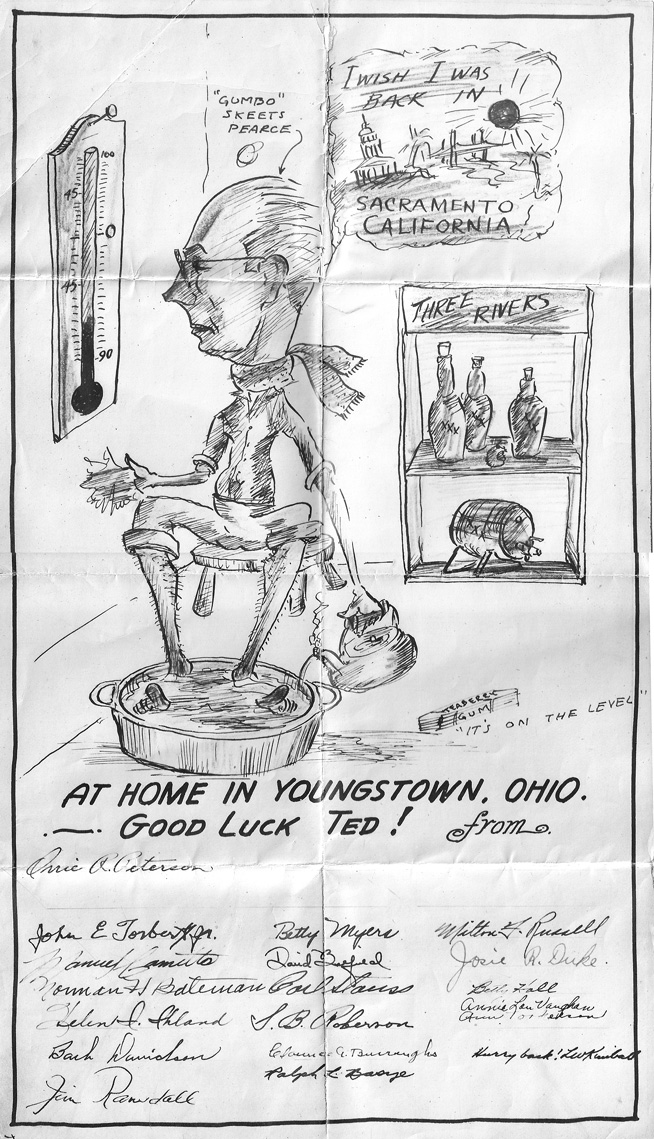
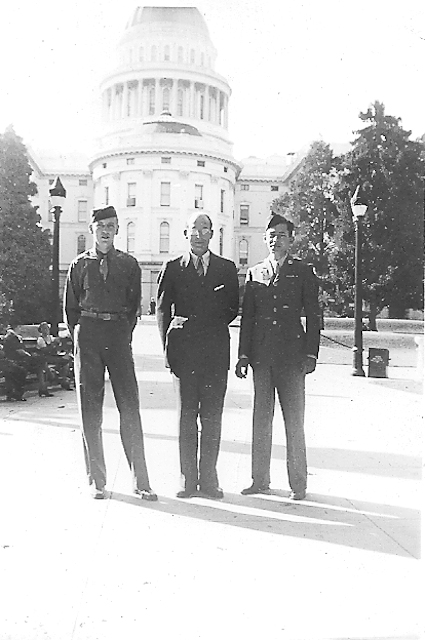
My Father had always told me stories while I was growing up about his being on the design team for the Norden Bomb Sight. His primary concern was the "bombardier to target" portion of the sight. He was stationed at McClellan Field. I have this "going away" cartoon from his co-workers before he left for home. I don't have a lot of information, just the old stories about base security, etc. I have enclosed the cartoon with signatures. He was very proud of his work, and was disappointed that it didn't work well with the Flying Wing.
Happy Holidays,
Bill Pearce
Thanks for sharing this information about your Father Bill.
There was a bombsight overhaul and maintenance facility at McClellan Field in Sacramento, California. This is also where Albert Pardini once worked. I wonder if they knew each other? Al Pardini wrote a book before he died called "The Legendary Norden Bombsight" which I have seen for sale on eBay and Amazon.com
October 27, 2009
Hi there,
It was with intense interest that I scrolled thru your informative web site. And I would much like to contribute a few words to the history that surrounds this marvelous instrument.
I joined the Marines in Sep't of 1941, and after boot camp, was assigned to duty at the Marine Air Base in Quantico, VA. The war started shortly after my arrival there. I then was picked to attend Navy bombsight school at the very secret Navy Proving Grounds at nearby Dahlgren, VA.
Our primary MOS in Aviation Ordnance would be that of a Bombsight Mechanic.I would be accompanied by three other picked Marines for this all-Navy school. We would also undergo a stiff bombardiering course, starting with a Link ground trainer, and then graduating to a real ancient Navy single engine, fabric coveredbiplane, the TG-1. However, the course finished with the use of the then modern Navy torpedo bomber, the TBD-1.
I shipped overseas in December of 1942, and landed on the American Samoa main island, where we were to try to set up an advanced aircraft repair base, as close to the front lines as possible.
While there,it was discovered that there were no otherbombsight mechanics inour large area of the Pacific.We flew several PBY's fromour airfield, mostly on rescue missions. But each plane was equipped with a Norden. I became a busy man. I had no manuals and no spareparts. The bombsight was mainly used for setting a precise course, this by locking in on the drift of the plane. We would simply take a "bombing run" on a breaking wave. It was an expensive tool forthe simple task ofdrift calculation. But, of more importance, we found that the autopilot was almost a necessity for pilots flying typical five-hour flights in thisflying boat with its over-sized rudder control surfaces. Without the aid of the autopilot, theMarine pilot would be leg-exhaustedby the end of his flight. Sometimes, we would have to help-carry him out of the plane.
After return to the States in 1944, I was assigned to a MarineAirbase in the Imperial Valley desert, near El Centro, CA. As the war seemed to be cranking down, we had a Lt. Buskirk who thought it would be dandy to start a bombardier school right therein the open desert wherebombs could be dropped without the danger of damage or casualties to humans. At the bombsight school in Dahlgren, no bombs were ever dropped due to proximity of civilization. The student readily learned his mistakes by following the movement of the bombsite'stelescope, after thepoint of release of the imaginary bomb.Our students would be freshly graduated Marines out of Navy Navigator school.
Here is where I would like to make my pitch for applauding the magnificent nature of this complex instrument, truly man's first real calculator. Here, at El Centro, I took on the role of flight instructor on the moving target course. As all bombardiers know, the Norden accurately calculates and sets the proper course for any moving target, providing that target moves in a fixed direction and at a fixed speed. However, if the target moves in an arc as do all Navy ships under attack, then the bombsite has its "hands tied". I'm sure most of your readers have seen films of Naval battles, showing a warship under attack from the air, and its wakeclearly outlineing the course that it is on, by thatof an arc. Then, one can see thedropped bomb exploding exactly where the ship would have been had it stayed on a straight course.This scene was played over and over in the Pacific. In the battle of Midway, the squadrons of B-17's never made a single hit on the Japanese fleet. This same scene was played in the New Guinea area, with the use of B-24's, or the Navy equivalent.
In this above scenario, you might want to fault the Norden, and scorn its inaccuracies. However, our school at El Centro taught the student how to overcome this shortcoming of theNorden.
To this veteran, it was, in every way, our secret weapon of WW11. For the most part, its manufacture was held to extremely high tolerances. I doown my own bombsight. I bought it from a man who worked in a factorymaking them. Hetalked endlessly about how rigid the factory's specs were. Sure, there were several areas that the bombsight could not do a perfect job. One was in the ballistic coefficient of the dropped bomb. This was a value that would be preset into one of the dials on the bombsight, and dealt with have fast the bomb fell, or travelled through the air to the target. There were two othersettings that could be in error. One was wind drift at different altitudes. The bombsite accurately calculated the wind drift at the altitude the plane flew. However, it is very common to have different wind directions at different altitudes. This would certainly put a plane off course if this pattern existed at any other altitude below the oneit was last flying. And last, but not least, was the altitude-temperature correction. Air weighs differently as temperature changes. The altitudereading then, is subject to error. All barometershave a correction factor with temperature. The bomb dropping through different air temps could have different ballistic coefficients.
All in all, the Norden bombsite did a marvelous job with the "tools" with which it was equipped.
Thanks for listening,
Walt Augustyniak
Thank you so much Walt for writing to us about your experiences. Thank you for your service as well. If you have anything else to write about please do so as it is great information.
September 22, 2010
Hello, I just viewed all the Photos and verbage you have on the Norden Bomb Sight. Back in the Early 40's, My mother used to build and rebuild Norden Bomb Sights. She has told me she aost count a about 100 of them. My mom is gone now, but I remember how proud she was to tell "us Kids" of the experiences she had, with her Team Members.
Just thought I'd share this with you, Thanks, William Weaver
On a recent trip to the national air space museum with my father and son I found out an interesting fact about My Grandfather Lewis Chester Sargent. When we came upon the Enola Gay father said to my son Connor who was 5 at the time “see that thing right there (pointing to the norden) your great grandfather used to make those”. He then went on to tell me my grandfather was a machinist at the navy yard in Washington DC during the war and every day an armed marine would open a safe and pull out blue prints and he would stand by for 8 hrs. while my grandfather worked on the norden. I had no Idea what he did at the Navy yard but now I do! Just something I thought you might find interesting.
Greg Sargent
Greg, Thank you for this
March 13, 2019
My dad, Robert Harper, was one of 2 men at Honeywell who worked on engraving the stabilizer and bombsight described here.
During World War II, Honeywell mass-manufactured tank periscopes, gunner's quadrants, mortars, and other artillery, while engineers continued to expand the uses of variable feedback-control, including the development and deployment of the C-1 automatic pilot. The same basic Honeywell system was used to keep an entire plane level for the top-secret Norden bombsight, an analog computer designed to predict the exact moment when a bombadier should relase their load of bombs onto the target below. This is no easy task even when the plane is flying at a constant speed and remaining perfectly level, but most pilots cannot achieve such a feat, and this was where Honeywell came in. By the end of the war, they had built 35,000 stabilizing autopilots with built-in bombsights. The autopilot was so successful that similar systems were adopted for a variety of aircraft deployed in the war.
Each man engraved half of the device so that they could not give up the entire secret if kidnapped. Each man had an FBI guard when not at work. During WWII, this was about as secret as the Manhattan Project.
I hope you can find room on your page for this information.
Nicki D. Harper, PhD
Thank you Nicki!
Help, Please!
Our museum is in need of any bombsights, parts, components, accessories and technical books, manuals or information for the Norden, Sperry, German, Japanese or any other bombsight. If you have anything that might be of interest please let me know by e-mailing me at taigh@twinbeech.com
We especially need bombardier class annuals and year books from any of the bombardier training bases like Albuquerque, NM, Childress, TX, Deming NM, Carlsbad, NM, Midland, TX, Victorville, CA etc. We hope to gather as much information as possible about bombardier training, bomb sights and all other aspects of the bombardier to post here for other's to learn and appreciate.
Thank you in advance for your help with this project.
MORE TO COME SO PLEASE CHECK BACK!

